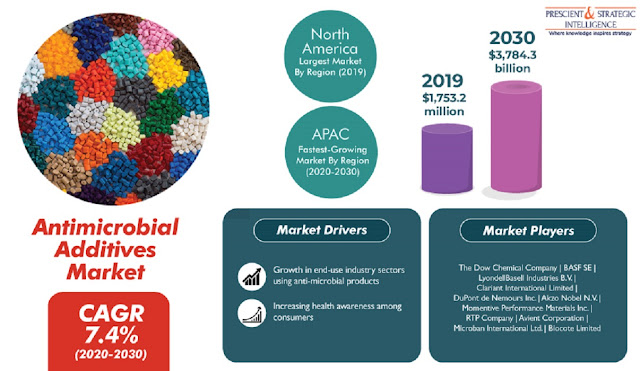Why Are Healthcare Facilities Using Antimicrobial Additives?
The Centers for Disease Control and Prevention (CDC) says that “On any given day, about 1 in 31 hospital patients has at least one healthcare-associated infection (HAI).” The incidence of HAIs is surging due to the frequent outbreaks of life-threatening diseases, such as COVID-19. Thus, the surging public awareness regarding health-related issues, such as harmful microbial spread and hygiene, will create a huge requirement for antimicrobial additives in healthcare facilities in the foreseeable future.
Additionally, the expanding healthcare and construction industries will help the antimicrobial additives market advance at a CAGR of 7.4% during 2020–2030. The market revenue stood at $1,753.2 million in 2019, and it is projected to reach $3,784.3 million by 2030. The surging adoption of novel drugs, accessories, and technologies and increasing use of antimicrobial additives are expected to bring a technological transformation in the construction and healthcare sectors. For instance, healthcare professionals and patients are currently opting for antimicrobial treatments to reduce the infection threat.
In recent years, antimicrobial additive manufacturers have engaged in collaborations and partnerships to strengthen their presence. For instance, in October 2020, Sanitized AG partnered with Ferro-Plast S.r.l. to use the expertise and expansive sales network of the latter in Italy. With this partnership, Ferro-Plast S.r.l. aims to enhance its product portfolio by adding the polymeric antimicrobial additives offered by Sanitized AG. Likewise, in December 2020, Dongpeng Group entered into a partnership with Microban International to develop ceramic tiles with antibacterial technology.
According to P&S Intelligence, North America led the antimicrobial additives market in the recent past due to the flourishing end-use industries and surging awareness about the characteristics of such additives. Whereas, the Asia-Pacific (APAC) region is expected to consume antimicrobial additives at the highest rate in the forthcoming years. This will be due to the expanding healthcare, construction, packaging, and food and beverage industries in the region. Additionally, the increasing need for hygienic products will fuel the adoption of these additives in the region.
Thus, the rising cases of HAIs and flourishing healthcare and construction sectors will fuel the consumption of antimicrobial additives in the upcoming years.



Comments
Post a Comment